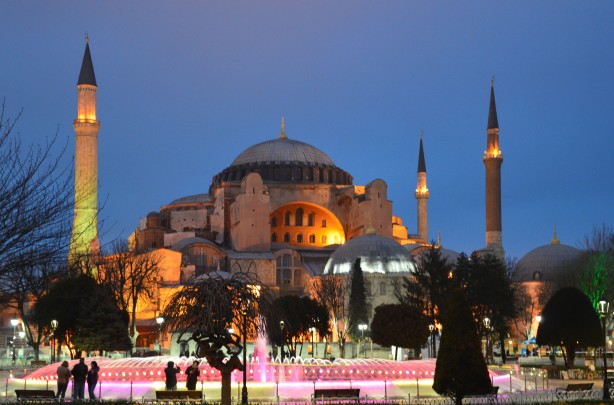All AP Art History Resources
Example Questions
Example Question #51 : Ancient Through Medieval Architecture

The interior of the building is likely decorated with __________.
encaustic designs
mosaics depicting biblical figures
rich oil paintings of Christian martyrs
precious metals
mosaics depicting biblical figures
The Hagia Sophia was built just after the birth of the Roman Christian tradition, and came well before the advent of Renaissance oil paintings in churches. It was also built in the Middle East, and was influenced by the artistic traditions of the area. It therefore likely has mosaics on the inside, which are the cornerstone of Byzantine church art.
Image adapted from http://www.publicdomainpictures.net/hledej.php?hleda=hagia+sophia+5.
Example Question #7 : Early Christian, Byzantine, And Early Medieval Architecture

Why would the Islamic Turks cover the mosaics on the interior of this structure with plaster?
The Turks did not appreciate mosaic art.
Islamic Turkish places of worship traditionally featured plain, undecorated interiors.
The Islamic tradition forbids the artistic depiction of figures.
The building was sacked, and the mosaics were taken apart and shipped to interested foreign parties.
The Islamic tradition forbids the artistic depiction of figures.
Islamic tradition bans the depiction of figures as inspiring idolatry; works depicting figures would be considered sacrilegious. When the church became a mosque, the mosaics were plastered over so that there were no faces in the new mosque, and there would only be Arabic script as decoration.
Image adapted from http://www.publicdomainpictures.net/hledej.php?hleda=hagia+sophia+5.
Example Question #11 : Early Christian, Byzantine, And Early Medieval Architecture

In the long history of the building, what has consistently been a concern of architects?
The ratio of brick to mortar
The weight of the dome
The outward shift of the buttressing
All of the other answers are correct.
All of the other answers are correct.
All of these are problems that have concerned and maddened builders since the construction of the building began, and all the problems are related to one other. The dome is very heavy, and when it's sitting on the foundation, it pushes the buttressing outward. The dome is so heavy in part because the brick to mortar ratio is 1:1, making the dense and heavy mortar far more weighty than it should be.
Image adapted from http://www.publicdomainpictures.net/hledej.php?hleda=hagia+sophia+5.
Example Question #12 : Early Christian, Byzantine, And Early Medieval Architecture

The structure reveals the influence of all but which of the following?
Medieval English Church style
Early Byzantine artistry
Roman secular structures
The Turkish Islamic architectural tradition
Medieval English Church style
The Hagia Sophia has been a Greek Orthodoxy church, a Roman Catholic Cathedral, a Mosque, and a museum. In fifteen hundred years of history, the building has seen influence from all over Europe. The minarets are Islamic, the mosaics on the interior are Byzantine, and the plan is Basilica, based on the Roman civic structures. What is has not ever seen the influence of, however, is the Church of England, which came about after the Hagia Sophia had already become a mosque.
Image adapted from http://www.publicdomainpictures.net/hledej.php?hleda=hagia+sophia+5.
Example Question #242 : 3 D Art
The dome of the Hagia Sophia Cathedral in Constantinople, built in 537 CE, was the first dome to be built using fully-developed __________.
a cloistered vault
an oculus
pendentives
a double barrel vault
pendentives
Upon its completion, the Hagia Sophia was the largest cathedral in the world, and also contained the largest dome in the world. This dome was achieved through the use of fully-developed "pendentives," triangular elements of a sphere used as structural supports to allow a dome to be raised over a square room. The Hagia Sophia's architectural innovations were widely copied in Orthodox churches and Muslim mosques in successive centuries.
Example Question #243 : 3 D Art
What is a tribune?
Monastery courtyard with covered walkways
Designs of Biblical scenes woven into cloth
Upper galleries over the inner aisle for overflow crowds
A series of radiating chapels
Upper galleries over the inner aisle for overflow crowds
Tribunes are galleries above the inner aisle that open down into the nave. These housed overflow crowds in Medieval churches, such as San Clemente in Rome.
Example Question #52 : Ancient Through Medieval Architecture
What is the drum of a building?
Floor under a dome
Circular opening of a dome
Wall that supports a dome
Dome
Wall that supports a dome
The drum of a building is the circular wall that supports a dome.
Example Question #251 : 3 D Art
What type of vaulting has has six sections?
Barrel vaulting
Quadripartite vaulting
Fan vaulting
Sexpartite rib vaulting
Groin vaulting
Sexpartite rib vaulting
In sexpartite rib vaulting, each vault is divided into six sections by three ribs.
Example Question #252 : 3 D Art
What is a pietá?
A painted or carved representation of the Annunciation
A painted or carved representation of Mary with a dead Christ in her arms
A painted or carved representation of the pious Mary
A painted or carved representation of a dying Christ
A painted or carved representation of Mary with a dead Christ in her arms
A pieta is a carved or painted artistic depiction of Mary holding her son Jesus in her arms after his crucifixion. When this depiction includes other people in the scene, it is referred to as the Lamentation.
Example Question #253 : 3 D Art
What is a finial?
A son or daughter depicted in an official portrait of a royal family
A small piece in a mosaic
A crowning ornament on a building
A decorative wall
A repeated design
A crowning ornament on a building
A finial is a crowning ornament on a pinnacle, tower, or roof of a building.
Certified Tutor
Certified Tutor
All AP Art History Resources



